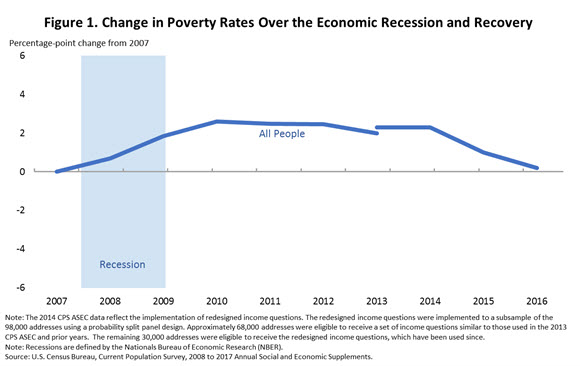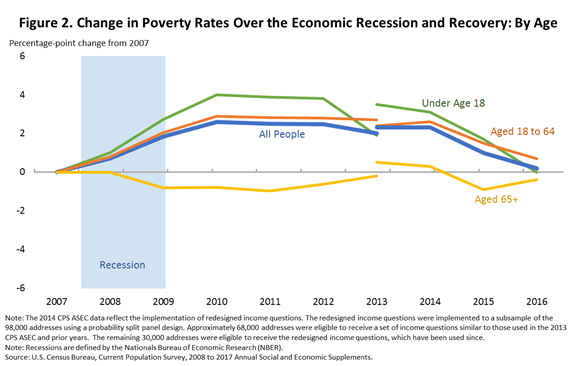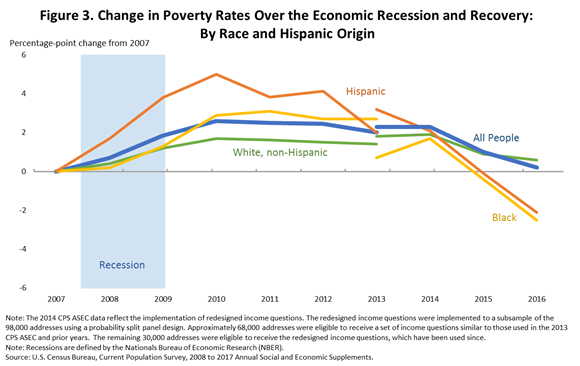Recovering from Recession: Who Recovered and When?
Recovering from Recession: Who Recovered and When?
Since June 2009, the U.S. economy has been experiencing what economists refer to as a “business cycle expansion.” This economic expansion follows the recession that ran 18 months from December 2007 through June 2009, making it the longest recession since 1929. These periods of recession and expansion are defined by the National Bureau of Economic Research.
While the expansion began in June 2009, the official poverty rate for the United States returned to its prerecession level for the first time last year. Data today from the Current Population Survey Annual Social and Economic Supplement, known as the CPS ASEC, indicate that in 2016, the poverty rate for the nation declined to 12.7 percent, not statistically different from the 2007 poverty rate.
As shown in Figure 1, in the first year of the recession, 2008, the overall poverty rate increased by 0.8 percentage points. The poverty rate would subsequently rise again in 2009 (1.1 percentage points) and 2010 (0.8 percentage points).
Poverty estimates for 2013 reflected a redesign of the income questions on the CPS ASEC. This redesign was implemented using a split panel design, meaning dual poverty estimates are available for 2013, one which provides a poverty rate consistent with the historical series (14.5 percent) and one reflecting redesigned income questions (14.8 percent) consistent with all subsequent years. The Census Bureau found that for the total population and for most demographic subgroups, differences in poverty rates across the two subsamples in 2013 were not statistically significant. Therefore, it is possible, with caution, to make comparisons to earlier years while keeping in mind that for some demographic groups, such as children and blacks, because of statistically significant differences across the 2013 estimates historical comparisons may not be appropriate.
The poverty rate declined from 2014 to 2015 by 1.2 percentage points and from 2015 to 2016 by 0.8 percentage points to 12.7 percent. This means for the first time since the end of the recession, the poverty rate was not statistically different from the prerecession poverty rate of 12.5 percent.
Figure 2 illustrates the differential impact of the recession across age groups. For working-age adults (ages 18 to 64) the poverty rate in 2016 was 0.7 percentage points higher than in 2007. Poverty rates for the population age 65 and over experienced little disruption from the economic downturn, with poverty rates never showing a statistically significant increase relative to the 2007 benchmark.
We also see a stark difference between Hispanic and other race groups, both in the impact of the recession and in the timing of returns to prerecessionary poverty rates. As shown in Figure 3, in the first year of the recession (2008), Hispanics experienced a large increase in poverty, with a 1.6 percentage point increase followed by consistently large increases in poverty in 2009 (2.1 percentage points) and 2010 (1.2 percentage points). However, Hispanics were also the first group to experience a decline in poverty over the recovery period, with rates declining 1.2 percentage points in 2011. Further, while non-Hispanic whites continued to have poverty rates higher than their 2007 baseline (0.7 percentage points higher in 2016), Hispanics had poverty rates 2.2 percentage points lower in 2016 than prior to the recession.
The Census Bureau invites data users to take advantage of the data today from the 2017 CPS ASEC in order to better understand individual’s current economic circumstances as well as how experiences over the course of the current economic expansion varied across population groups.






